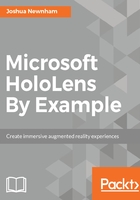
Identifying the type of experience you want to create
As discussed earlier, the degree of reality you want to preserve is up to you--the application designer. It is important to establish where your experience fits early on as it will impact how you design and also the implementation of the experience you are building. Microsoft outlines three types of experiences:
Enhanced environment apps: These are applications that respect the real world and supplement it with holographic content. An example of this can be pinning a weather poster near the front door, ensuring that you don't forget your umbrella when the forecast is for rain.
Blended environment apps: These applications are aware of the environment, but will replace parts of it with virtual content. An application that lets the user replace fittings and furniture is an example.
Virtual environment apps: These types of applications will disregard the environment and replace it completely with a virtual alternative. An application that converts your room into a jungle, with trees and bushes replacing the walls and the floor can be taken as an example.
Like with so many things, there is no right answer, just a good answer for a specific user, specific context, and at a specific time. For example, designing a weather app for a professional might have the weather forecast pinned to the door so that she sees it just before leaving for work, while it might be more useful to present the information through a holographic rain cloud, for example, to a younger audience.
In the next section, we will continue our discussion on the concepts of MR, specifically looking at how HoloLens makes sense of the environment.